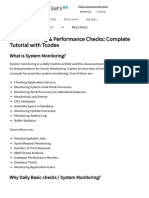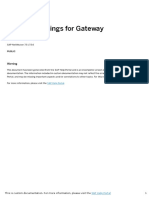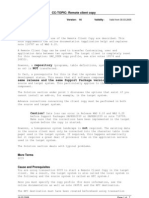Memory Management in 7.4 - Kernel
Memory Management in 7.4 - Kernel
Uploaded by
Juan Carlos Jacinto OrtizCopyright:
Available Formats
Memory Management in 7.4 - Kernel
Memory Management in 7.4 - Kernel
Uploaded by
Juan Carlos Jacinto OrtizOriginal Title
Copyright
Available Formats
Share this document
Did you find this document useful?
Is this content inappropriate?
Copyright:
Available Formats
Memory Management in 7.4 - Kernel
Memory Management in 7.4 - Kernel
Uploaded by
Juan Carlos Jacinto OrtizCopyright:
Available Formats
Memory Management simplifications in ABAP
Kernel 7.4*
Memory Management simplifications in ABAP Kernel 7.4*
2
TABLE OF CONTENTS
OVERVIEW ....................................................................................................................................................... 3
NEW PARAMETER FORMULAS ..................................................................................................................... 3
TROUBLESHOOTING ...................................................................................................................................... 4
512 GB LIMIT .................................................................................................................................................... 5
CONCLUSION ................................................................................................................................................... 5
Memory Management simplifications in ABAP Kernel 7.4*
3
OVERVIEW
This paper describes Memory Management parameterization changes in 7.4* kernel. The main goal of these
changes was simplification: the administrator will be enabled by setting only one profile parameter
PHYS_MEMSIZE to automatically initiate changes of dependent parameters. This is a fast way to scale the
ABAP instance memory consumption. Within the context of this development the old fashioned Zero Admin
MM for Linux and Windows
- was extended to all other operating systems
and
- reimplemented via formula based parameters
More information about the Zero Administration in previous releases can be found in:
http://help.sap.com/saphelp_erp60_sp/helpdata/en/3c/05863c6800924fe10000000a114084/content.htm
http://help.sap.com/saphelp_erp60_sp/helpdata/en/84/7ed384d81f11d188be0000e83539c3/content.htm
NEW PARAMETER FORMULAS
The formulas may depend on kernel release and operating system. You can get a list of parameters with
formula based default values e.g. with help of sappfpar executable. Below is an example for kernel 7.41
PL22 on Linux:
Formulas support in the profiles is implemented as of kernel 7.40, described in:
http://help.sap.com/saphelp_nw74/helpdata/en/a7/d631e255594dc19899706a3a7c3fe8/content.htm?frames
et=/en/51/319798cc7a428a896af0bc2a00adc7/frameset.htm
> sappfpar all | grep "SAP: ("
abap/buffersize = (ceil($(em/initial_size_MB)*1024*0.15/4096) * 4096)
abap/heap_area_total = (max($(PHYS_MEMSIZE)*1024*1024 * 0.1, $(abap/heap_area_dia) * 2 ))
abap/programs = ($(abap/buffersize)/4)
abap/shared_objects_size_MB = (min(20000, $(em/initial_size_MB)*0.02))
em/blocksize_KB = (ceil($(em/initial_size_MB) * 1024 / 100000 / 4096) * 4096)
em/global_area_MB = (min($(em/initial_size_MB) * 0.05, 32000))
em/initial_size_MB = (min(512000, $(PHYS_MEMSIZE) * 0.7))
em/max_size_MB = ($(em/initial_size_MB))
rdisp/PG_SHM = (max(min(1000+40*max(5,floor(($(PHYS_MEMSIZE)-128)*25/128)),16384),1024))
rdisp/max_websocket_connections = ( $(rdisp/tm_max_no) / 2 )
rdisp/wp_ca_blk_no = ($(rdisp/elem_per_queue)*3)
rsdb/ntab/entrycount = ($(zcsa/db_max_buftab))
rsdb/ntab/ftabsize = (min(500000, ($(rsdb/ntab/entrycount))))
rsdb/ntab/irbdsize = ($(rsdb/ntab/ftabsize) * 0.2)
rsdb/ntab/sntabsize = ($(rsdb/ntab/ftabsize) * 0.1)
rsdb/obj/buffersize = (max(4096,$(PHYS_MEMSIZE)*1024 * 0.01))
rsdb/obj/max_objects = (max(2000,$(rsdb/obj/buffersize) / 4))
rsts/ccc/cache07 = ($(rsts/ccc/cachesize) * 0.1)
rtbb/buffer_length = ($(zcsa/table_buffer_area) * 0.1 / 1024)
rtbb/max_tables = ($(zcsa/db_max_buftab) * 0.1)
zcsa/db_max_buftab = (max(20000,$(zcsa/table_buffer_area) / (5 * 1024) ))
zcsa/table_buffer_area = (min(3333333333, (max(30000000,($(em/initial_size_MB) * 1024 * 1024 * 0.1)))))
ES/SHM_MAX_SHARED_SEGS = ( ($(em/global_area_MB) + $(abap/shared_objects_size_MB) + $(rtbb/buffer_length)/1024 +
$(zcsa/table_buffer_area)/1024/1024 ) / $(ES/SHM_SEG_SIZE) + 1 )
Memory Management simplifications in ABAP Kernel 7.4*
4
sappfpar can also be used for checking your profile:
In the example above the parameter abap/buffersize that has been set to a fix value although its default
value is a formula, was found.
TROUBLESHOOTING
In this section we would like to analyze a real life example from an administrators point of view.
A system consisting of 2 ABAP instances is installed on a host with 64GB main memory. Every instance is
running with PHYS_MEMSIZE=30% setting in profile. Customers experience sporadic memory lack issues
- Rabaxes
- EmAlloc failed errors in dev trace
- Extended Memory Dump in dev trace
Examples for memory lack Rabaxes are: TSV_TNEW_PAGE_ALLOC, LOAD_NO_ROLL,
STRING_LENGTH_TOO_LARGE, TSV_TNEW_BLOCKS_NO_ROLL_MEMORY
The administrator is analyzing Extended Memory Dumps in dev traces, they appear as shown below:
The administrator cant identify any particular user which is using too much memory. This means that the
server has been overloaded sporadically, i.e. at peak times when many users are working simultaneously.
>sappfpar pf=<ProfileName> check_formula
***WARNING: formula parameter: abap/buffersize = 350000 found in profile
Errors detected..................: 0
Warnings detected................: 1
...
...
Extended Memory Dump
Act. USER SUM IM0 IM1
_________________________________________________________________
SAP_SMDMON(T52_U5144_M0) [ 0.9] > 0.8< ------
0990FUSRABCD(T461_U4228_M0) [ 23.8] > 23.6< ------
USER_TEST_12(T461_U4228_M0) [ 23.8] > 23.6< ------
...
...
# CHAIN OWNER STATE
0 0 ***free*** free
1 1 EG_GLOBAL_AREA shared
...
2537 1 EG_GLOBAL_AREA shared
2538 2538 SAP_SMDMON(T6_U377_M0) detached
2539 2539 K8NZDJEQHUR(T558_U15419_M0) detached
...
Memory Management simplifications in ABAP Kernel 7.4*
5
Proposed solution: set PHYS_MEMSIZE=45% in the profile to allow every instance to use
64GB * 0.45 = 28,8GB
main memory. This will automatically increase the value of dependent parameters, e.g:
PHYS_MEMSIZE=30% PHYS_MEMSIZE=45%
em/initial_size_MB
13653 (MB) 20480 (MB)
abap/heap_area_total
20452265165 (Byte) 30678397747 (Byte)
Keep in mind that the instance has to be restarted for activating its new values!
PHYS_MEMSIZE can be also set to absolute values instead of percentage:
PHYS_MEMSIZE=40000
which would mean Megabytes in the Example above.
512 GB LIMIT FOR ALL OPERATING SYSTEMS
PHYS_MEMSIZE is not a hard limit for an ABAP instance. This is a guide value to make the instance
aware about the amount of main memory it should use. This limit can be overrunned in heavy load
scenarios.
Kernel 7.4* has been tested up to PHYS_MEMSIZE=512000 settings. It is not recommended to run a
singular ABAP instance with more than 512000 MB.
Warnings in dev traces would give you a hint if you are trying to run an instance with more than that
memory size, e.g.:
* WARNING=>DpCheckParams: invalid value for PHYS_MEMSIZE=600000 [dpInit.c]
* WARNING=>DpCheckParams: check message: Parameter value out of range (16...512000) [dpInit.c]
It is recommended to use default memory management models on every OS:
es/implementation = std (Unix)
es/implementation = view (Windows)
ES/TABLE = UNIX_STD (Unix)
ES/TABLE = SHM_SEGS (AIX only)
The memory management parameter formulas have been optimized for the memory model cases above.
The only platform has been optimized not for default case only is OS/400 which has been tuned for both
UNIX_STD and SHM_SEGS memory models.
CONCLUSION
Formula based parameters introduced in 7.4* and supported for all operating systems offer a new simplified
way of administration for ABAP instances in an SAP system. They will be used in ABAP server memory
management already.
About the author: Gennady Maly is working at SAP development since 2001.
2014 SAP AG. All rights reserved.
SAP, R/3, SAP NetWeaver, Duet, PartnerEdge, ByDesign, SAP
BusinessObjects Explorer, StreamWork, SAP HANA, and other SAP
products and services mentioned herein as well as their respective
logos are trademarks or registered trademarks of SAP AG in Germany
and other countries.
Business Objects and the Business Objects logo, BusinessObjects,
Crystal Reports, Crystal Decisions, Web Intelligence, Xcelsius, and
other Business Objects products and services mentioned herein as
well as their respective logos are trademarks or registered trademarks
of Business Objects Software Ltd. Business Objects is an SAP
company.
Sybase and Adaptive Server, iAnywhere, Sybase 365, SQL
Anywhere, and other Sybase products and services mentioned herein
as well as their respective logos are trademarks or registered
trademarks of Sybase Inc. Sybase is an SAP company.
Crossgate, m@gic EDDY, B2B 360, and B2B 360 Services are
registered trademarks of Crossgate AG in Germany and other
countries. Crossgate is an SAP company.
All other product and service names mentioned are the trademarks of
their respective companies. Data contained in this document serves
informational purposes only. National product specifications may vary.
These materials are subject to change without notice. These materials
are provided by SAP AG and its affiliated companies ("SAP Group")
for informational purposes only, without representation or warranty of
any kind, and SAP Group shall not be liable for errors or omissions
with respect to the materials. The only warranties for SAP Group
products and services are those that are set forth in the express
warranty statements accompanying such products and services, if
any. Nothing herein should be construed as constituting an additional
warranty.
www.sap.com
You might also like
- HA250 - Database Migration Using DMO - SAP HANA 2.0 SPS05Document107 pagesHA250 - Database Migration Using DMO - SAP HANA 2.0 SPS05srinivas6321No ratings yet
- Memory and Disk Sizing of SAP Process Orchestration PDFDocument5 pagesMemory and Disk Sizing of SAP Process Orchestration PDFAdyhincuNo ratings yet
- Accenture Upstream Production Operations SAP TrainingDocument8 pagesAccenture Upstream Production Operations SAP Trainingdezire12363No ratings yet
- Tips For Improved Short Dump Analysis in ST22Document8 pagesTips For Improved Short Dump Analysis in ST22Devender ReddyNo ratings yet
- JMIGMON State Properties: Restart: Lesson: Controlling The JLOAD ProcessesDocument70 pagesJMIGMON State Properties: Restart: Lesson: Controlling The JLOAD ProcessesKrishna ChaitanyaNo ratings yet
- DBA Cockpit Automatic Table Maintenance For Sybase ASE PDFDocument19 pagesDBA Cockpit Automatic Table Maintenance For Sybase ASE PDFfernandez_joe16315No ratings yet
- How To Install Sap Smart Business ApplicationDocument25 pagesHow To Install Sap Smart Business Applicationprasad kkavNo ratings yet
- How To Extend The SAP FIORI App HCM Timesheet ApprovalDocument26 pagesHow To Extend The SAP FIORI App HCM Timesheet Approvalnikebara100% (1)
- Top 10 ABAP DumpsDocument7 pagesTop 10 ABAP DumpsSiva CheniNo ratings yet
- SAP Memory ManagementDocument25 pagesSAP Memory ManagementShiviNo ratings yet
- SAP interface programming with RFC and VBA: Edit SAP data with MS AccessFrom EverandSAP interface programming with RFC and VBA: Edit SAP data with MS AccessNo ratings yet
- Day 5 - HANA User AdministartionDocument12 pagesDay 5 - HANA User AdministartionDIGITAL TELUGUNo ratings yet
- Dpmon & SappfparDocument2 pagesDpmon & SappfparAnant SinghNo ratings yet
- Use Self-Signed SSL Client Certificate To Connect SAP Backend To SCPI With Custom Domain Configured - SAP BlogsDocument9 pagesUse Self-Signed SSL Client Certificate To Connect SAP Backend To SCPI With Custom Domain Configured - SAP Blogsniel romanoNo ratings yet
- SAP Monitoring & Performance Checks - Complete Tutorial With TcodesDocument20 pagesSAP Monitoring & Performance Checks - Complete Tutorial With TcodesMahesh RaiNo ratings yet
- R3trans HelpDocument1 pageR3trans HelpSiddesh RaulNo ratings yet
- ST05Document2 pagesST05Gowtham Ravi100% (1)
- SWPM 10 Processes SystemRenameDocument5 pagesSWPM 10 Processes SystemRenameJose Rebola GomesNo ratings yet
- Kernel - Upgrade Using SUM - Software Update ManagerDocument10 pagesKernel - Upgrade Using SUM - Software Update Managermhku1No ratings yet
- LiveCache Start and StopDocument10 pagesLiveCache Start and StopalamitabNo ratings yet
- Performance AnalysisDocument12 pagesPerformance AnalysisGvds SastryNo ratings yet
- Acl Gateway SapDocument25 pagesAcl Gateway SapSyed ImranNo ratings yet
- PI XI Monitoring Daily Check ListDocument2 pagesPI XI Monitoring Daily Check Listgauravpanwar8No ratings yet
- Charm Cutover and Activation Guide in Solution Manager For Managed System LandscapeDocument17 pagesCharm Cutover and Activation Guide in Solution Manager For Managed System LandscapeInamull Hussain100% (1)
- Sap Hana Q&A: AnswerDocument2 pagesSap Hana Q&A: AnswerjNo ratings yet
- Best Practice Document For Housekeeping in SAPDocument7 pagesBest Practice Document For Housekeeping in SAPv jayNo ratings yet
- How To Configure HANA LogDocument3 pagesHow To Configure HANA LogVenkatesh VenkatNo ratings yet
- Tadm10 Curricula PDFDocument3 pagesTadm10 Curricula PDFRavinder Pal SinghNo ratings yet
- Upload SG HANA Replication - Part 1Document3 pagesUpload SG HANA Replication - Part 1Prabhu KnNo ratings yet
- Mover Datafile Ejecutando Brtools Command SAPDocument2 pagesMover Datafile Ejecutando Brtools Command SAPadelimaNo ratings yet
- SM 100Document47 pagesSM 100Mohd Abdul RaheemNo ratings yet
- Sap Solman Charm Administrativecorre 2615Document9 pagesSap Solman Charm Administrativecorre 2615iranna kitturNo ratings yet
- Note 557132 - CC-TOPIC: Remote Client Copy: Repository NOTDocument7 pagesNote 557132 - CC-TOPIC: Remote Client Copy: Repository NOTChristophe Van LanNo ratings yet
- Upgrade Sap Ehp7 JavaDocument38 pagesUpgrade Sap Ehp7 JavaRohit KanthNo ratings yet
- EWA Configuration in Newly Installed SAP ABAP System With Screenshots (Part - 1) - SAP BlogsDocument22 pagesEWA Configuration in Newly Installed SAP ABAP System With Screenshots (Part - 1) - SAP BlogssampathNo ratings yet
- Spool AdministrationDocument18 pagesSpool Administrationmohamed hassballahNo ratings yet
- 1 Sap Products Supported by SWPM .Sar - Systems Based On Sap Netweaver 7.1 and HigherDocument6 pages1 Sap Products Supported by SWPM .Sar - Systems Based On Sap Netweaver 7.1 and Highererwin menesesNo ratings yet
- SAP EP MonitoringDocument70 pagesSAP EP MonitoringnandineeNo ratings yet
- Solution Manager 7Document24 pagesSolution Manager 7Md Abdullah Al MamunNo ratings yet
- C - TADM23 - SAP S4HANA System AdministrationDocument28 pagesC - TADM23 - SAP S4HANA System AdministrationArvindNo ratings yet
- BR ToolsDocument8 pagesBR ToolsSurya NandaNo ratings yet
- Basis Notes From ITSITIDocument43 pagesBasis Notes From ITSITIDeep BlueNo ratings yet
- SAP System Administration Made Easy008Document75 pagesSAP System Administration Made Easy008Surendra KumarNo ratings yet
- Configuration GuideDocument99 pagesConfiguration Guideandrealeger755774No ratings yet
- Detailed Analysis of Monitoring Process: Standard System ChecksDocument37 pagesDetailed Analysis of Monitoring Process: Standard System ChecksRam PrasadNo ratings yet
- SAP Backup and Restore For DRDocument2 pagesSAP Backup and Restore For DRSurendra KumarNo ratings yet
- Bdls in Less Than 2 HoursDocument18 pagesBdls in Less Than 2 HoursvincentoliNo ratings yet
- SAP Web Dispatcher: RecommendationDocument6 pagesSAP Web Dispatcher: RecommendationrubyNo ratings yet
- SAP MaxDB - Apply PatchesDocument9 pagesSAP MaxDB - Apply Patcheshttp://wlacaze.googlepages.com/home50% (2)
- Solman SystemDocument22 pagesSolman SystemArif SomuncuNo ratings yet
- Adm200 New Qs AnswersDocument6 pagesAdm200 New Qs AnswersSampath Kumar KvNo ratings yet
- Manually Process An EWA ReportDocument4 pagesManually Process An EWA ReportPepeNo ratings yet
- HANA System Replication OverviewDocument7 pagesHANA System Replication OverviewmouladjNo ratings yet
- Install SAP HANA Database and HANA Live Cache - SAP HANA Training Tutorials For Beginners, S - 4HANA, B - 4HANA TutorialDocument9 pagesInstall SAP HANA Database and HANA Live Cache - SAP HANA Training Tutorials For Beginners, S - 4HANA, B - 4HANA TutorialRajKumarNo ratings yet
- Sap Performance MonitoringDocument7 pagesSap Performance MonitoringJ Agostinho O JuniorNo ratings yet
- SAP BO 4 1 Installation Guide - LinuxDocument24 pagesSAP BO 4 1 Installation Guide - LinuxtuancoiNo ratings yet
- UI5 Theme ExercisesDocument73 pagesUI5 Theme ExercisesChandra Sekhar BattulaNo ratings yet
- LSMW For Assigning Characteristics Profile To Merchandise CategoriesDocument31 pagesLSMW For Assigning Characteristics Profile To Merchandise CategoriesBipin ShuklaNo ratings yet
- Demystifying The Usage of Sub-Items in is-OIL TSWDocument21 pagesDemystifying The Usage of Sub-Items in is-OIL TSWmagforuNo ratings yet
- How To... Master Data Governance For Material: Set Up Parallel Change Requests For MaterialDocument15 pagesHow To... Master Data Governance For Material: Set Up Parallel Change Requests For MaterialRamesh VaradaNo ratings yet
- HANA Alert 66 Storage Snapshot Is PreparedDocument12 pagesHANA Alert 66 Storage Snapshot Is PreparedivanNo ratings yet
- B2B Roadmap in The Context of SAP PIDocument48 pagesB2B Roadmap in The Context of SAP PIjawaharcse1No ratings yet
- Quick Step-By-Step Guide To Apache Split Deployment With BI4.1Document8 pagesQuick Step-By-Step Guide To Apache Split Deployment With BI4.1RavinderPalSinghNo ratings yet
- NFE 10.0 - Master Guide Version 1.4 For NFE 10.0 SP11Document28 pagesNFE 10.0 - Master Guide Version 1.4 For NFE 10.0 SP11Deivison FerreiraNo ratings yet
- How-To Guide For CustomizationDocument13 pagesHow-To Guide For Customizationpraveenr58830% (1)
- MDG-M Dif-1Document13 pagesMDG-M Dif-1skkumar1981No ratings yet
- Wiring in Floor PlanDocument23 pagesWiring in Floor PlanDeepak SinghNo ratings yet
- RtftftftfDrtrdtdtrdP363 SolutiyftdtdtdtdtdtdtddonsDocument44 pagesRtftftftfDrtrdtdtrdP363 SolutiyftdtdtdtdtdtdtddonsHari SreyasNo ratings yet
- NFE10 Master Guide en v13Document26 pagesNFE10 Master Guide en v13dri0510No ratings yet
- H2G Install SAP Web IDE Locally For Trial (Mac Version)Document24 pagesH2G Install SAP Web IDE Locally For Trial (Mac Version)Andres VargasNo ratings yet
- SAP TM - How To Determine The BO Field That Is Displayed in A UI FieldDocument7 pagesSAP TM - How To Determine The BO Field That Is Displayed in A UI Fieldsapabap403No ratings yet
- Dynamic Row and Column Calculation in BPC ReportsDocument5 pagesDynamic Row and Column Calculation in BPC ReportsAkhlaque ShamsiNo ratings yet
- SAP Belgium Partner List-4Document18 pagesSAP Belgium Partner List-4bebetto38No ratings yet
- Work Order and Notification Assignment Types Supported in Work Manager 5.3Document16 pagesWork Order and Notification Assignment Types Supported in Work Manager 5.3Gian Carlo IINo ratings yet
- BW Source System: Troubleshooting Guide: P. Mani Vannan SAP Labs IndiaDocument14 pagesBW Source System: Troubleshooting Guide: P. Mani Vannan SAP Labs Indiarao_okcNo ratings yet
- Memory Management in 7.4 - KernelDocument6 pagesMemory Management in 7.4 - KernelJuan Carlos Jacinto OrtizNo ratings yet
- Fiori Analytical App Configuration Steps For Beginners SAP BlogsDocument10 pagesFiori Analytical App Configuration Steps For Beginners SAP BlogsVilas PatilNo ratings yet
- 108c972c-1fa5-3010-b68b-b8ddaeeb95f7Document43 pages108c972c-1fa5-3010-b68b-b8ddaeeb95f7coolguypj1953No ratings yet
- How To Extend A SAP Fiori App (HCM - TS - APV) From Remote Using The Extensibility Pane PDFDocument20 pagesHow To Extend A SAP Fiori App (HCM - TS - APV) From Remote Using The Extensibility Pane PDFnikebaraNo ratings yet
- Joining Text Tables To Replace Technical Names With Descriptions in The HANA View For Drilldown Search PDFDocument10 pagesJoining Text Tables To Replace Technical Names With Descriptions in The HANA View For Drilldown Search PDFRajaNo ratings yet
- Belajar ConfigDocument16 pagesBelajar ConfigkerbarousNo ratings yet
- Resource Tracking Scenario For SAP Transportation Management PDFDocument30 pagesResource Tracking Scenario For SAP Transportation Management PDFsaptmNo ratings yet
























































































